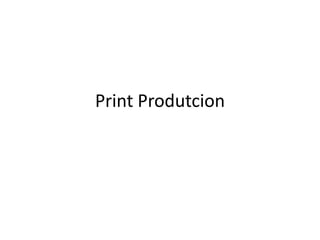Print produtcion
- 2. Hand printing • Linocut is a printmaking technique, a variant of woodcut in which a sheet of linoleum (sometimes mounted on a wooden block) is used for the relief surface. A design is cut into the linoleum surface with a sharp knife! V- shaped chisel or gouge, with the raised (uncarved) areas representing a reversal (mirror image) of the parts to show printed. The linoleum sheet is inked with a roller (called a brayer), and then impressed onto paper or fabric. The actual printing can be done by hand or with a press. This technique was used in the 1950s. • Advantages. carving is enabled, printing is possible, embossing is enabled, rubbing, tough and sturdy, different surfaces, easy for simple designs • Disadvantages. Mistakes are unreversible, it is not 3D, you have to work hard to get texture, hard to cut, limited colour application, hard to clean, hard to get off hands, long time to dry, Time consuming .
- 3. Mechanical printing • Gravure printing is commonly used for labels and packaging, competing against flexography. Photogravure is a process used mostly for fine art prints. • Advantages. photographic quality, bright colors, best possible appearance and highest perceived value for your product. Its main disadvantage is the high cost and the time needed to engrave gravure cylinders.
- 4. Digital Printing • Photocopying is where you can get a photo that you like and you can make an exact copy of the same photo. • Photocopying is widely used in business, education, and government. There have been many predictions that photocopiers will eventually become obsolete as information workers continue to increase their digital document creation and distribution, and rely less on distributing actual pieces of paper. • advantages,are that you can dublicate your imagaes in a quick, easy to use, cheap process. • Disadvantages, are that the ink can become expensive.
- 5. Types of printing Print Technique Definition Advantage Disadvantage Hand: Etching metal plates, from which designs and pictures are printed. saves paper, low in cost, fast to produce. cant produce very high quality prints. Hand: Linocut A design is cut into the linoleum surface with a sharp knife. The linoleum sheet is inked with a roller and then impressed onto paper or fabric. The actual printing can be done by hand or with a press. you can do carving, printing, embossing rubbing, tough and sturdy, different surfaces, easy for simple designs Mistakes are irreversible, it is not 3D, you have to work hard to get texture, hard to cut, limited colour application, hard to clean, hard to get off hands, long time to dry, Time consuming . Hand: Screen print is a technique in which an ink- blocking stencil is printed onto a woven mesh. it makes good quality prints. the stencils are fragile . Hand: Woodcut a carved block of wood from which prints are made. cheap material longwinded process. Hand: Lithography A printing process in which the image to be printed is rendered on a flat surface, as on sheet zinc or aluminum, and treated to retain ink while the nonimage areas are treated to repel ink You can print any picture you want onto a sheet of metal. someone needs to know how to do it. Mechanical: letterpress The process of printing from a raised inked surface it can be used again and again to mass produce copies. it cannot be used to print complex imagery. Mechanical: gravure Gravure printing is commonly used for labels and packaging, competing against flexography. Photogravure is a process used mostly for fine art prints. photographic quality, bright colours, best possible appearance and highest perceived value for your product high cost and the time needed to engrave gravure cylinders.
